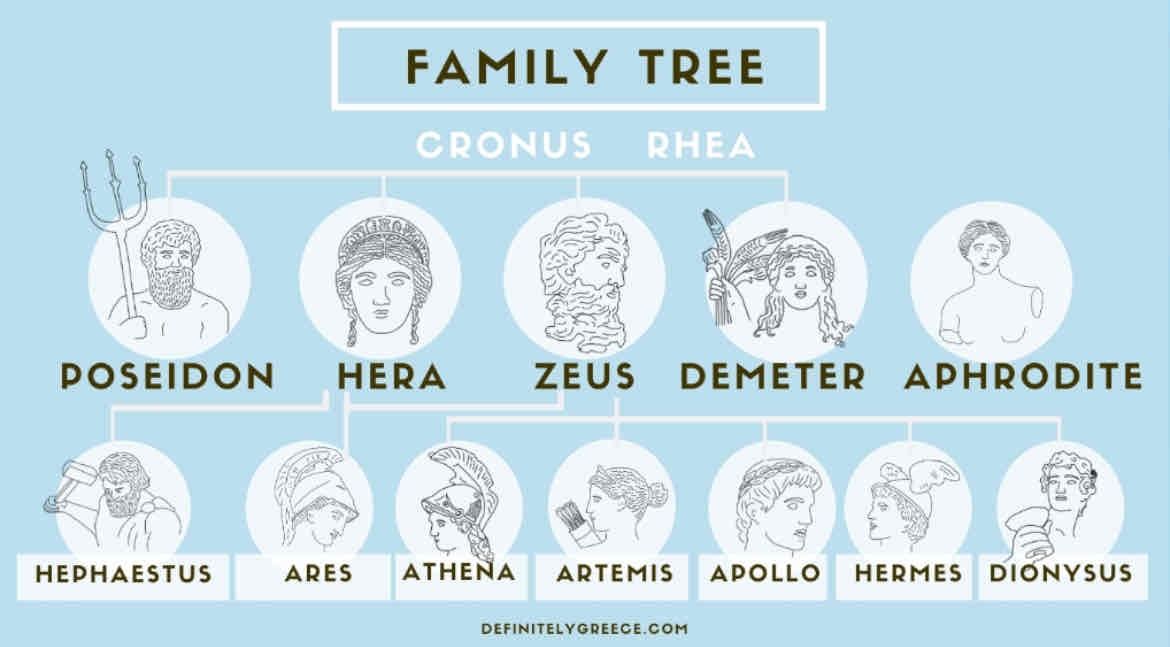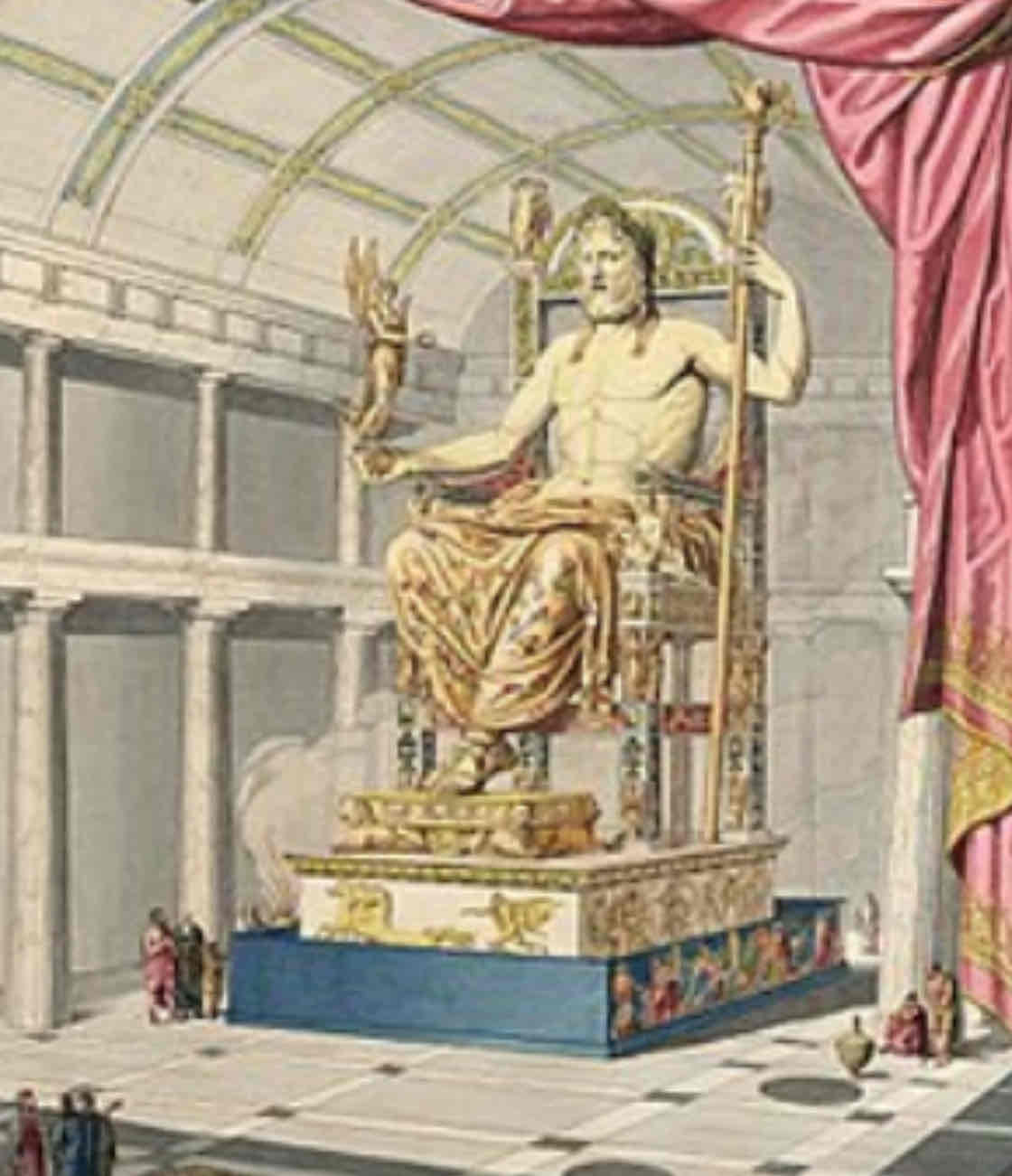GREEK MYTHOLOGY
1/25
There's no tags or description
Looks like no tags are added yet.
Name | Mastery | Learn | Test | Matching | Spaced |
|---|
No study sessions yet.
26 Terms
MYTH
an oral story about deities passed through generations explaining a natural or social idea to a group of people.
FAIRYTALE
a children’s story about a land far away including magical and supernatural beings often for the purpose of entertainment with the presence of the dichotomy of good vs evil.
LEGEND
a story about real life people and their actions, often exaggerated and thought to be historical but is not authenticated.
HOW WERE THE GREEK GODS FORMED
The Ancient Greeks believed that in the beginning, the world was in a state of nothingness which they called Chaos. Suddenly, from light, came Gaia (Mother Earth) and she mated with Uranus (the sky) which they had 12 titans together.
The two Titans Cronus and Rhea mated, and their mother Gaia ordered Cronus to kill Uranus as he was a bad father, so Cronus grabbed his father and castrated him, with the stone sickle, throwing the severed genitals into the ocean. This formed the six gods, Zeus, Poseidon, Hades, Hera, Hestia, and Demeter. (Cronus and Rhea children.)
However, Cronus had fear that his children would overthrown him like he did to his father so he ate all of them except zeus because Rhea had stopped him. After Zeus grew up, he rescued his siblings by forcing Cronus to vomit them up after serving him poiuson. Zeus and his siblings rebelled, fighting a long war against Cronus and most of the Titans and eventually overthrowing them → (Olympians vs Titans)
EXPLANATORY MTYHS
Myths are used to explain the unexplainable/ explain causes of origins in the natural world
Synonym: ethnological myths
Ex; persophene myth → how winter came to be
DIDACTIC MYTHS
Teaches humans about something, usually a lesson/moral/value
Ex; Prometheus steals fire for humans → dont steal or you will be punished.
FAMILY TREE

ZEUS
Chief deity of the pantheon of gods - King of the gods, god of the sky and thunder
Son of Cronus and Rhea

EAGLE NEAR ZEUS REPRESENTS ROLE AS GOD OF SKY
ZEUS THUNDERBOLT REPRESENTS HIS CONTROL OVER SKY AND HIS ROLE AS THE GOD OF STORM/LIGHTNING
SCEPTER SMYBOLISES ROLE AS RULES OF GODS
SEATED ON THRONE DEPICTS HIS SURPREME POSTION OVER GODS/HUMANS
BEARDED/MUSCULAR APPEARNCE SHOWCASES MATURE MAN WITH WISDON AND MALE AUTHORITY LIKE CHARCTERISTIS THORUGH PHYSICAL MUSCULAR FEATURES
PERSOPHENE MYTH
Persephone in the underworld → winter on earth, no growing of crops because of Demeter tried
Persephone reunited with mother → signals fertile growth and growth in crops again
Persephone eats 6 pomegranate seeds → ties her to the underworld for 6 months
Humans learning how to deal with seasons → winter storage of crops, spring: fertile agriculture growth
ICARUS MYTH
Daedalus and Icarus’ Imprisonment → this ssymbolises how cleverness and skill (Daedalus )can sometimes lead to entrapment, as powerful people may exploit or control talented individuals
Creation of Wings → the wings represent human integrity and the potential to overcome limitations or barriers through creativity and knowledge
Warning Against Flying Too High or Too Low → this warning signifies the importance of balance and moderation, ax extremes whether arrogance or fear - can lad to downfall
Icarus’ Ignorance of the Warning → this act of defiance or recklessness represents youthful ambition and the temptation to push beyond limits, often without fully understanding the consequences.
Melting of the Wax Wings → this events illustrates the danger of hubris (excessive pride) and the fragility of human-made solutions when tested against natural forces or limits
Icarus’ Fall into the Sea → his fall serves as a cautionary tale about the consequences of failing to heed advice, as well as the tragic results of overreaching or failing to recognise personal limits
Daedalus’ Grief and the Lesson of the Myth → this ending emphasises the price of wisdom learned too late and serves as a reminder that ambition and innnovation must be tempered with respect for limits and guidance.
ELEUSINIAN MYSTERIES
Held initiations for the cult of Demeter and Persephone (agrarian cult)
Rites kept secret - rebirth of Persephone symbolised eternity of life from generation to generation
Initiates believed to have a reward in the afterlife
LOCATION: sanctuary of Demeter
HOW TO EXPLAIN ANDORA BOX
EXPLANAOTRY
explains evil in the world
explains the dichotomy between good and evil
hope and goodness in the world
DIDACTIC
dont be too curious
have self control
don’t go against what you’re tolf
part of human nature to be curious
Explain both of these versions and add an extend for example; THE MYTH OF PANDORA’S BOX IS A DIDACTIC MYTH TO A MODERATE EXTENT AS IT ALSO HAS EXPLANATORY ELEMENTS
WHAT IS PANDORA BOX
Zeus creates Pandora as the first woman
Pandora is given a box (or jar) and told not to open it
Pandora opens the box out of curiosity
All evils and miseries escape from the box
Hope remains at the bottom of the box
Pandora closes the box, trapping Hope inside
Humanity must now deal with the consequences
HERAIA
The main festival in Argos was the Heraia, dedicated to Hera, the goddes
The festival took place annually in the spring.
The Heraia was celebrated at the Heraion of Argos, an ancient sanctuary dedicated to Hera located just oupside the city.
The festival included a grand procession to the Heraion, sacrifices, athletic competitions, and feasting. The central event was the presentation of offerings to honor Hera.
The Heraia likely lasted several days, although specific records of the exact duration are unclear.
GYMNOPAEDIA
The most significant festival in Sparta was the Gymnopaedia, dedicated primarily to Apollo but also honoring the warrior culture of Sparta and its values of endurance and discipline.
The Gymnopaedia took place annually in the summer, during the Spartan month of Hekatombaion (roughly July).
It was held in public spaces in Sparta, notably the Agora (main public square).
The festival involved dances, athletic competitions, and performances by young Spartan boys and men, showcasing their physical prowess, discipline, and martial skills. It was both a cultural and physical celebration, reinforcing Spartan ideals and military readiness.
The Gymnopaedia lasted for five days.
DIONYSIUS
The festival was called the City Dionysia (or Great Dionysia), dedicated to Dionysus, the god of wine, fertility, and theater.
The City Dionysia was celebrated annually in late March to early April
The main events took place in Athens, particularly at the Theater of Dionysus on the southern slope of the Acropolis.
The festival included processions, sacrifices, and theatrical competitions where playwrights presented tragedies, comedies, and satyr plays. The festival was also an opportunity for citizens to participate in civic celebrations, honoring Dionysus and celebrating the arts
The City Dionysia lasted for approximately five to six days.
LIBATION
Libation is a ritual pouring of liquid as an offering for a deity or spirit. A libation most often consisted of mixed wine and water, but could also be unmixed wine, honey, oil, water, or milk. Libation generally accompanied prayer. The Greeks stood when they prayed, either with their arms uplifted, or in the act of libation with the right arm extended to hold the rhyton. In conducting animal sacrifice, wine is poured onto the offering as part of its ritual slaughter and preparation, and then afterwards onto the ash and flames. This scene is commonly depicted in Greek art, which also often shows sacrifices or the gods themselves holding the
SACRIFICE
Animal sacrifice is the ritual killing and offering of an animal, usually as part of a religious ritual or to appease or maintain favour with a deity. Animals included bull, cow, goat, sheep, pig. It would be cleaned, dressed up in ribbons, and taken in a procession to the temple. Altars were almost always outside in front of the temple. Animal throat was slit and blood poured into a receptacle. Long bones with fat continued to burn so smoke can reach the gods. Meat given to the humans to eat. This is part of communal feasting.
PROCESSIONS
Processions are parades of groups who move towards a sanctuary or altar in order to. perform a ritual act
They are described as well-performed movements with music, incense, ani- mals, gifts, and wagons
OFFERINGS
They took the form of bloodless offerings such as grasses, roots, cereal grains, fruits, cheese, oil, honey, milk and incense, or were blood-offerings like wild and domesticated animals, birds and fish.
MUSIC
Strings, winds and percussion. The most common musical instruments were the flute and the lyre. An integral part of ancient greek music was also song. People through song expressed pain, sadness, nostalgia and joy.
DANCE
In Ancient Greece, dance was a form of ritual, as well as a pastime. Dance could be included in hunting communities, initiation ceremony rituals of age, marriage, and death, entertainment, dance festivals, and religious activity.
ORACLES AND OFFERINGS
A Greek oracle is an ancient women that will speak on the behalf of those that seek guidance/communication from the gods and their answrs would be yes or no or very ambiguous/vague.
EUSEBIA → piety → doing your duties publicly, sacrifice festivals
ETHOS → having good character, genorisity
ARETE → living up to your full potential, competition, arts, music, poetry, theatre (EXCELLENTE)
OLYMPIAN GAMES
4 GAMES THAT HONOURED THE GODS:
4 GAMES THAT HONOURED THE GODS:
-OLYMPIC GAMES → ZEUS
-PYTHIAN → APOLLO
-ISTHIAN GAMES → POSIEDEN
-NEMEAN GAMES → HERCULES
Inception day was 776 BCE
Olympiad’s = every 4 years
Competition fosters excellence → Arete
The first olympics were only running (2020 yard dash)
Boxing
Chariot racing
Wrestling
Discus/throwing
Foot lace
Sporting events and contests for music, singing and poetry
The three cheers, cities, Altus, fortius
Symbol of peace because war stopped in all of Greece
Hellenic means greece
Danehlic Greece and everything around
PANANTHENIA
This was the most important festival in Athens. The festival took place every four years, lasted 12 days and included rituals, sacrifices, as well as athletic and musical contests.
This festival could be attended by everybody except for slaves, and was in honour of the goddess Athena.
It would start with a procession and this would assemble before dawn in the northern sector of the city. The procession would be led by kanephoros (unmarried young woman) from Ancient Greece.
A woman would be selected from an aristocratic family of Athens. Her purity and youth would ensure a successful sacrifice to the gods.
The woman would carry a kanoun (basket) of barley or fruits, a sacrificial knife and fillets to decorate a bull. She would then carry this through the procession up to the great altar of Athena on the Acropolis at the Temple of Athena Nike.
Festivals were also part if the religious rituals in Ancient Greece that included processions, sacrifice, musical and athletic contests. The festival included young unmarried women leading processions for a sacrifice at the altar of Athena at the acropolis of the Temple of Athena Nike. Part of the procession of the Parathenea is depicted in the frieze of the Parathenean procession showing men on horses.